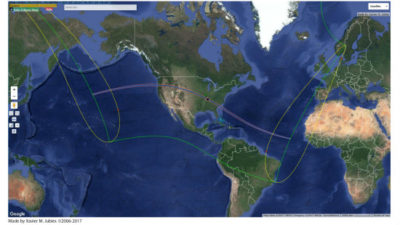Classes, Events and the Path of Totality
Millions of Americans are eagerly anticipating the ultimate sky show: a total solar eclipse on Aug. 21. This rare, once-in-a-lifetime event is described by greatamericaneclipse.com as “easily the most spectacular site in nature when the sky suddenly darkens and the most beautiful object in the sky — the Sun’s shimmering corona — becomes visible for two minutes or so.”
The path of totality for the solar eclipse will cross the United States from Oregon to South Carolina, making Missouri a state of major impact. Here are a few things to keep in mind as you begin planning your day on Aug. 21.

Path of Totality:
Thousands of Missourians are flocking to St. Joseph to view the eclipse at totality. Although there is a wide band across the state that will experience at least a 90 percent eclipse, the Missouri Department of Transportation says there is a 300-mile-long and-70 mile-wide path where you can see a total eclipse. The eclipse in Missouri will begin at about 1 p.m. in St. Joseph, proceed southeast and exit the state near Perryville at 1:45 p.m. Here in Kansas City, the eclipse viewing zone includes the metro area north of the Missouri River, and in the downtown area from the river south to the general vicinity of Truman Road. Viewing glasses can be purchased from the UMKC Bookstore located inside the student union.
Is UMKC Closing the Campus?
The university gave careful thought to the decision of whether or not to shut down for the eclipse. Due to location – UMKC is not within the path of totality – and the number of services our students and constituents heavily rely on, the campus will remain open. Faculty have the discretion, however, of whether to cancel class during the time of the eclipse and are also encouraged to incorporate the eclipse into their lesson plans if they do not cancel. Several faculty and student groups have plans to travel to St. Joseph to view the eclipse at total impact and participate in activities led by the Astronomical Society of Kansas City.
UMKC’s Warko Public Observatory, located on campus, will close on Aug. 21. Visit the Physics and Astronomy Department webpage for useful information on safe viewing, local and regional events, and visualization and maps.
UMKC Eclipse Projects, Activities
Though eclipse viewing activity will be limited on campus, faculty and staff are taking advantage of the opportunity to use the eclipse to advance research and educate the public on the significance of this rare occurrence happening in the sky.
Warko Public Observatory Operations Manager Joe Wright is working with the National Solar Observatory at Timberline Observatory, located east of Watkins Mill State Park, as a regional coordinator for the Citizen CATE (Continental America Total Eclipse) Experiment. Wright, alongside co-coordinator David Young, has been working with seven sites along the path of the eclipse to collect images from the entire path of totality for analysis to examine, discover and determine why the corona reaches a temperature of nearly 2 million degrees K and possibly learn what mechanism is at work causing this phenomena.
CATE coordinators will invite, organize and train astronomers, researchers students and citizens at each site location using identical equipment (telescope, camera and laptop computer) provided by the NSO to image the corona. Sites include Hiawatha and Atchison, Kansas; and Lawson, Marshall, Columbia, Freeman and Hillsboro in Missouri.
CATE coordinators will conduct a public presentation on campus at 7 p.m. Friday Aug. 18 in Royal Hall, room 104, informing students, staff and the public about how and where to observe the eclipse.
Associate Professor of Civil Engineering Dr. ZhiQiang Chen is leading a team of specialists from UMKC, University of Missouri Extension and University of Missouri-Columbia to develop drone technology that will assist emergency management directors (EMDs) by providing real-time disaster information.
The project will use imaging drones and smart applications to send images to a remote cloud infrastructure for GIS (geographic information system) integration and advanced analytics in real time. The team is taking advantage of the unique opportunity to use the Aug. 21 solar eclipse to test their data collection methods and software by analyzing and reporting on the heavy traffic expected within the zone of totality.
UMKC Departments of Chemistry and Physics & Astronomy will host a joint presentation on what to expect when the solar eclipse arrives. During the presentation, UMKC alumnus James Dire, Ph.D. of the University of Hawaii System will speak on his extensive experience with total solar eclipses and detail a number of interesting experiments that can be done during a total solar eclipse.
The colloquium presentation will take place from 3:30 – 4:30 p.m. Aug. 18 in Flarsheim Hall, room 310.
Planning to travel for the solar eclipse? Take note of these driving tips provided by the Missouri Department of Transportation.

